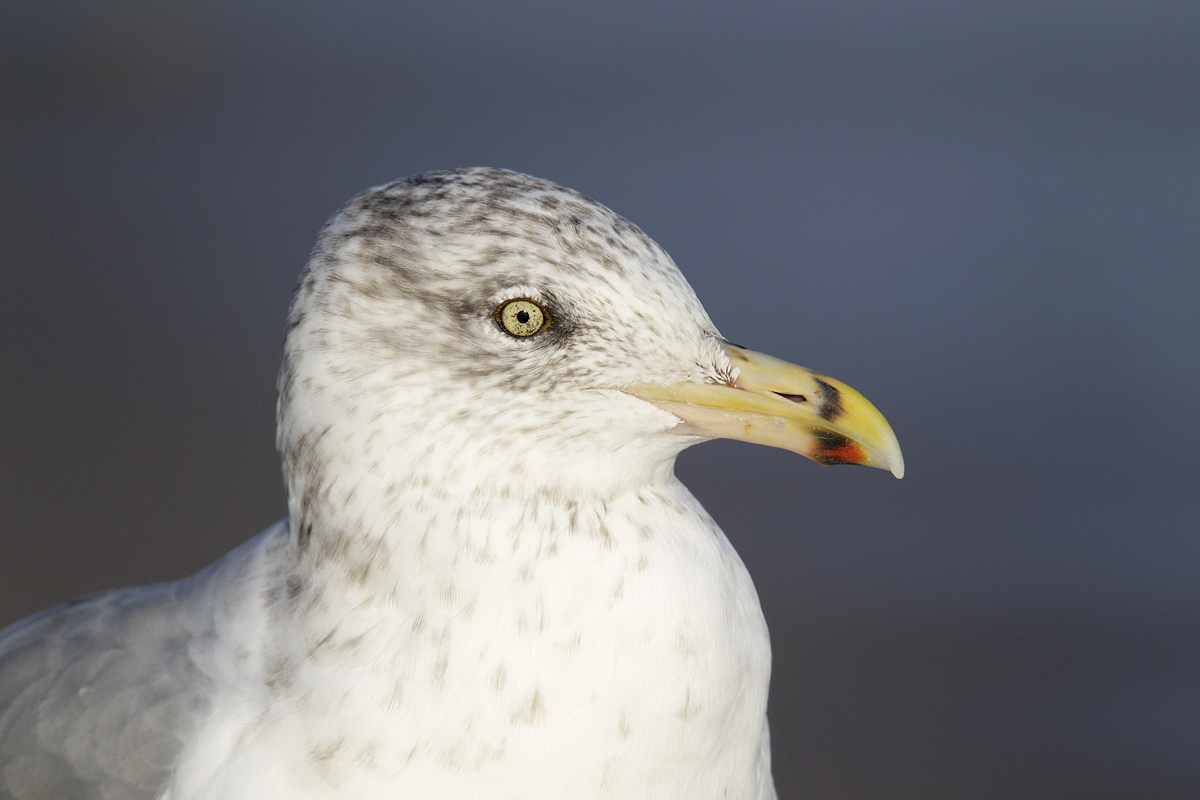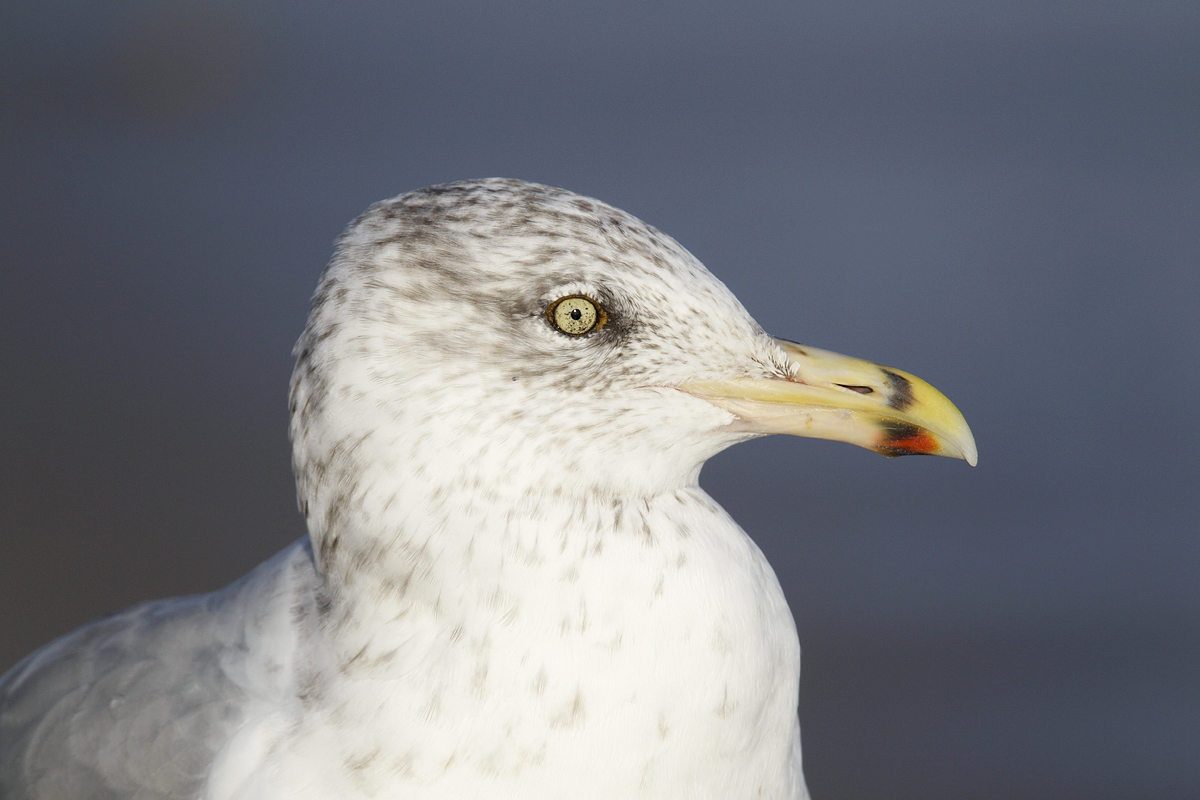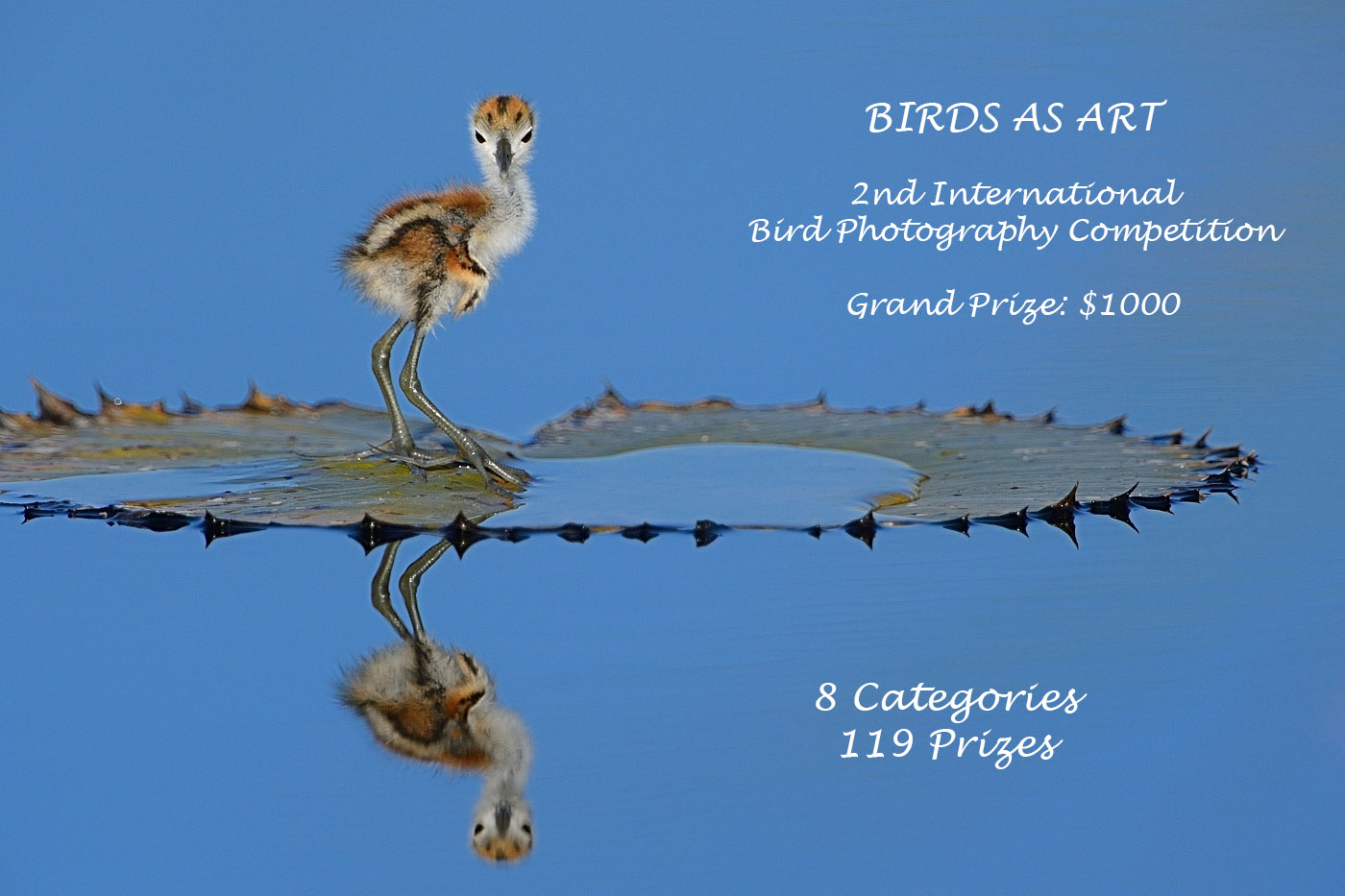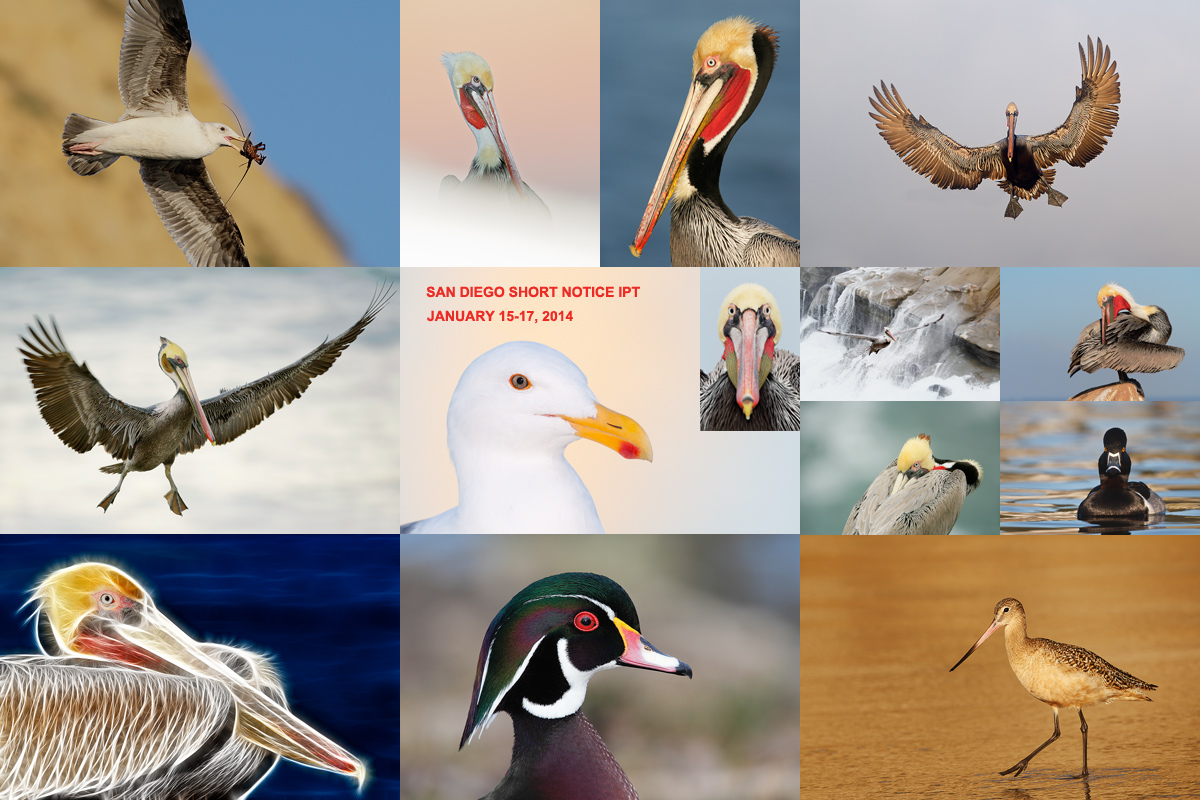
|
|
This Herring Gull was photographed at Cupsogue Beach, Long Island, NY with the predecessor of the Gitzo 3532 LS carbon fiber tripod, Mongoose M3.6 head, the Mongoose M3.6 head, the Canon EF 800mm f/5.6L IS USM Autofocus lens, the Canon 1.4x EF Extender III (Teleconverter), and the EOS-1D Mark IV (since replaced by the Canon EOS-1D X). ISO 400. Evaluative metering at zero: 1/250 sec. at f/8 (wide open) in Manual mode. Central sensor (by necessity)/AI Servo Rear Focus AF as framed active at the moment of exposure. Click here to see the latest version of the Rear Focus Tutorial. Click on the image to see a larger version. Sitting behind my lowered tripod resulted in an intimate look to the image with a pleasing Atlantic Ocean background. |
Head Angle, Head Angle, Head Angle…
Many bird photographers are totally oblivious to head angle when they push the shutter button. Understanding what makes a good head angle is a complex issue that requires both common sense and study. Many folks assume incorrectly that having the bird’s head perfectly parallel to the imaging sensor is always the best head angle but this is true only 5-10% of the time….
Let’s cut to the chase: which image features the best head angle. And why?
Folks that photograph with me quickly notice that I almost always make images of static birds in 3-frame bursts. There are several reasons for this:
1-The frame-rate of the 1D X is so fast that it is hard to take 1 (or even 2) images when you press the shutter button.
2-Birds have a third eyelid called the nictitating membrane. This translucent membrane covers the eye several times a minute, just as when we blink. Having the nictitating membrane cover the eye of your subject most often ruins an image.
3-Birds are rarely completely still. Like me, they are constantly looking around. Thus, the head angle is often changing from moment to moment. Case in point: both images in this blog post were created in the same one-one hundredth of a second as follows: Date/Time: 2009:10:04 17:05:52. Rather than try to anticipate the perfect head angle I choose to make 3 or 4 images every time that I like a shot. This practically ensures a good head angle as it did here. The question remains, which head angle (HA) is best, A or B?

|
|
This, the same Herring Gull as above, was of course also photographed at Cupsogue Beach, Long Island, NY with the predecessor of the Gitzo 3532 LS carbon fiber tripod, Mongoose M3.6 head, the Mongoose M3.6 head, the Canon EF 800mm f/5.6L IS USM Autofocus lens, the Canon 1.4x EF Extender III (Teleconverter), and the EOS-1D Mark IV (since replaced by the Canon EOS-1D X). ISO 400. Evaluative metering at zero: 1/250 sec. at f/8 (wide open) in Manual mode. Central sensor (by necessity)/AI Servo Rear Focus AF as framed active at the moment of exposure. Click here to see the latest version of the Rear Focus Tutorial. Click on the image to see a larger version. |
El Capitán…
My awareness of the importance of head angle probably came to fruit well more than two decades ago. On page 141 of the original “The Art of Bird Photography,” the classic how-to work on the subject, there are two images of a young Great Black-backed Gull, one with a good head angle and one with the head turned away. In various online forums I routinely–in an attempt to educate folks–busted them for poor head angles. At first the common reaction was “What is he talking about?” But over time, folks did learn and in the process I became known as “Captain of the Head Angle Police,” a title I wear proudly.
The very best way (aside from studying the images post here every day and in BAA Online Bulletins), is to study the “Head Angle Fine Points” tutorial that I started in August, 2010 in the Educational Resources (ER)Forum on BirdPhotographers/Net (BPN). You can read the entire thread here but beware, there are 383 comments…. Still, it represents a tremendous free learning opportunity for those who wish to improve their bird photography.
The funny thing is that when I comment on head angle now some folks respond by asking, “Who says that you are right? Did you make this stuff up?” My answers are always the same: “Me. And Yes.”
BPN’s Educational Resources (ER) Forum
The Educational Resources (ER) Forum on BPN is surely the most over-looked free nature photography resource on the web. And in recent years it has become even more neglected…. Check it out; you will be amazed at what you will find.
|
Join me in San Diego for three great days of photography and learning. Click on the image to better enjoy a larger version. |
Only 1 Slot Left! Call or e-mail for Late Registration Discount info.
The San Diego Short-Notice Small Group IPT. January 15-17, 3-Full Days: $1049. Meet and Greet after dinner on your own at 7:30pm on Tuesday, January 14, 2014. Limit 6/Openings: 1.
We will get to photograph the California race of Brown Pelican in flight, resting, preening, cleaning their bill pouches, and talking to their neighbors by tossing their bills high in the air. The afternoon sessions will feature Marbled Godwits, several gull species, and Wood and Ring-necked Ducks. If we have a cloudy morning we will get to photograph Harbor Seals. You will learn to get the right exposure every time, to see the best situation, to think like a pro, to create sharp, pleasing images, and to understand the joint effects of light and wind on the birds. All in a small group with tons of individual attention.
A $500 non-refundable deposit is required to hold your slot for this IPT. Your balance will be due no later than January 7, 2014. The balance is also non-refundable. If the trip fills, we will be glad to apply a credit applicable to a future IPT for the full amount less a $100 processing fee. If we do not receive your check for the balance on or before the due date we will try to fill your spot from the waiting list. If your spot is filled, you will lose your deposit. If not, you can secure your spot by paying your balance.
If you are planning to register please shoot me an e-mail.
Then please print, complete, and sign the form that is linked to here and shoot it to us along with your deposit check (made out to “Arthur Morris.”) Though we prefer a check, you can also leave your deposit with a credit card by calling the office at 863-692-0906. If you register by phone, please print, complete and sign the form as noted above and either mail it to us or e-mail the scan.
If you have any questions, please feel free to contact me via e-mail
San Diego Site Guide
Can’t make the IPT? Get yourself a copy of the San Diego Site Guide; it’s the next best thing to being on an IPT. Nearly 30 years of San Diego bird photography revealed in one fell swoop.


IPT Info
Many of our great trips are filling up. You will learn more about how to make great images on a BAA IPT than anywhere else on the planet. Click here for info on the Anhinga Trail IPT. Click here for info on the Estero Lagoon IPT. And click here to learn about the just-announced 2014 Bosque IPTs. You will find additional IPTs and general info here.
Great Buy: Used Canon 800mm f/5/6L IS Lens for Sale
Friend and multiple IPT-veteran Monte Brown is offering his lightly used Canon 800mm f/5.6L IS lens in excellent condition for sale for $9,500. Purchase includes the lens case and hood, the 4th Generation Design Low Foot, the original foot, a LensCoat, the original invoice and the original Canon shipping carton. The lens was purchased new from B&H in April 2009 and was recently underwent a pre-sale clean and check by Canon. The buyer pays insured shipping via UPS Ground to US addresses only. The lens will be shipped only after your check clears.
The Canon EF 800mm f/5.6L IS USM Autofocus lens sells new for $13,223.00 so you will save a bundle on a great lens. No need to ever use a 2X…
If interested you can contact Monte by phone at 1-765-744-1421 or via e-mail.
Last Year’s Grand Prize winning image by Lou Coetzer

|
Time is Running Out!
BIRDS AS ART 2nd International Bird Photography Competition
The December 31, 2013 closing deadline is fast approaching.
Learn more and enter the BIRDS AS ART 2nd International Bird Photography Competition here. Twenty-five great prizes including the $1000 Grand Prize and intense competition. Bring your best.
Support the BAA Blog. Support the BAA Bulletins: Shop B&H here!
We want and need to keep providing you with the latest free information, photography and Photoshop lessons, and all manner of related information. Show your appreciation by making your purchases immediately after clicking on any of our B&H or Amazon Affiliate links in this blog post. Remember, B&H ain’t just photography!




Amazon
Everyone buys something from Amazon, be it a big lens or deodorant. Support the blog by starting your search by clicking on the logo-link below. No purchase is too small to be appreciated; they all add up. Why make it a habit? Because I make it a habit of bringing you new images and information on an almost daily basis.
Typos
In all blog posts and Bulletins feel free to e-mail or leave a comment regarding any typos, wrong words, misspellings, omissions, or grammatical errors. Just be right. 🙂















Great job by everyone. Yes, A is the best by far. In B, even though the head is square to the imaging sensor it is actually turned away from the bird’s body. For me that is less than ideal….
Image A—has more tilt (towards you) in the head.
You might be proud to wear the title “captain of the head-angle police,” and indeed you’ve taught me a lot in that capacity, but I always think of you as the one who says “point your lens at a gull and it will do something interesting.” I have so many images that please me from following that advice. So thank you. I prefer A as well, because it’s more interesting, even though it’s a gull, and gulls always are interesting. 🙂
I was at Bosque today; it’s such an amazing place. Saw two of your wonderful images in the visitor center.
Happy new year.
I know I’m making to much of this, but also look at
the sun reflection in the eye.
In A the spot is between noon and one. In B, when the
gull turns his head slightly away, the spot is more
around 11.
Doug
Good point Doug!
image A because the beak is more oblique where as image B the eye and beak are too parallel and so compete as focus point.
typo: that having the bird’s head perfectly parallel to the imaging sensor is always the best head angle but his is true only 5-10% of the time….
should be but this is true only 5-10% of the time.
Good catch Howard. It has been fixed.
I vote for A. The birds eye is exactly pointing towards me, while in B it is slightly away, eventhough his head is perpendicular to the viewing point.
I think A has a more esthetic and natural head angle.